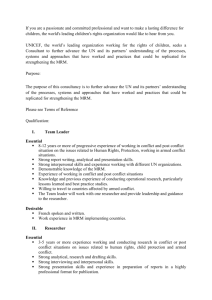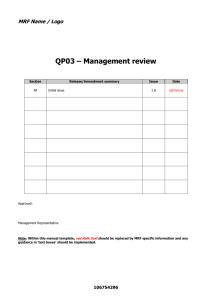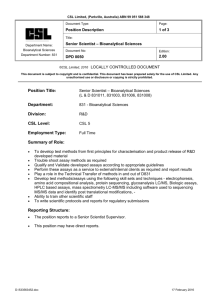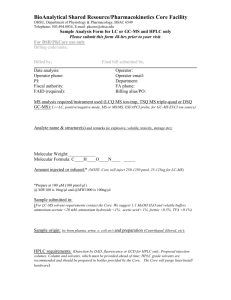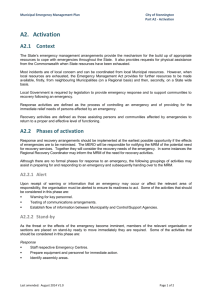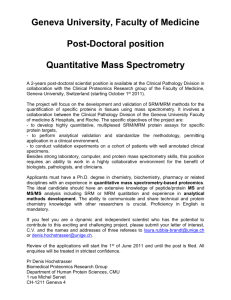Dr. Olah presentation - University of Connecticut
advertisement
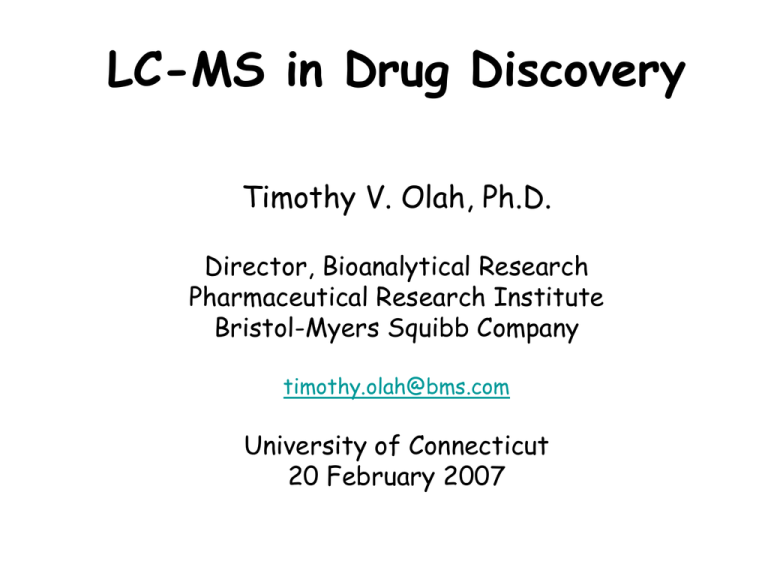
LC-MS in Drug Discovery Timothy V. Olah, Ph.D. Director, Bioanalytical Research Pharmaceutical Research Institute Bristol-Myers Squibb Company timothy.olah@bms.com University of Connecticut 20 February 2007 Drug Discovery Programs at BMS Wallingford, CT: Virology: HIV (AIDS), Hepatitis C, CNS: Anxiety, Depression, Alzheimer’s, Migraine Lawrenceville, NJ: Oncology: Cancer Immunology: Rheumatoid Arthritis, Asthma Hopewell, NJ: Cardiovascular: Thrombosis, Atherosclerosis Metabolic Diseases: Diabetes, Obesity BMS Bioanalytical Research Wallingford: Deborah Barlow, Marc Browning, Mike Donegan, Daniel Morgan, Kim Snow, Sarah Taylor, Kim Widmann Lawrenceville: Hollie Booth, Chris Caporuscio, Georgia Cornelius, Celia D'Arienzo, Lorell Discenza, Mohammed Jemal, Zheng Ouyang, Asoka Ranasinghe, Bogdan Sleczka, Yi Tao, Xia Yuan, Jian Wang, Steven Wu Hopewell: Hong Cai, Cecilia Chi, Jim Smalley, Minjuan Wang, Richard Wong, Baomin Xin, Carrie Xu, Hongwei Zhang, Joanna Zheng Bioanalytical Research Staffing • • • • • • • Personnel: 30 scientists Location: WFD (7), LVL (13), HPW (9) Mass Spectrometers : 30 MS/MS Full Phase Programs: 34 Early Phase Programs: 25 Research Initiatives Samples 1-4Q 2006: ~184,000 Total Number of Samples Analyzed by BAR (FTE) in Support of Discovery 200000 Total samples 184056 175000 150000 139789 145795 125000 100000 84335 75000 65672 56618 50000 25000 0 2001 (7) 2002 (10) 2003 (14) 2004 (19) 2005 (19) 2006 (20) BAR-Discovery Annual Sample Count Compounds compounds analyzed 3000 2632 9203 10000 2533 8500 2500 6567 2000 6024 7355 7673 2225 7000 5500 1500 1730 1672 4000 1000 2500 500 1000 0 -500 2002 (10) 2003 (14) 2004 (19) 2005 (19) 2006 (20) samples per analyst per BAR FTE Outline • LC-MS in Drug Discovery • Drug Discovery Process • Strategies and Work Flow Processes • Development and Implementation of Multiple Component LC-MS-based Bioanalytical Methods • Examples, Questions, Comments • What is of interest to you today in regards to the Pharmaceutical Industry ? Bioanalytical Research’s Goal To generate accurate and precise data in the quantitative analysis of drug discovery candidates in samples from in vivo and in vitro studies that support their biological characterization and optimization as potential development candidates. The Gilbert Bioanalytical Chronicles “The challenges of bioanalysis stem from the need to accurately and reproducibly measure part per million to part per trillion quantities of analyte in complex biological matrices, full of potentially interfering endogenous or drug-related substances.” John Gilbert et al., “High Performance Liquid Chromatography with Atmospheric Pressure Ionization Tandem Mass Spectrometry as a Tool in Quantitative Bioanalytical Chemistry,” in Biochemical and Biotechnological Applications of Electrospray Ionization Mass Spectrometry, American Chemical Society (1995) Relative Amounts 1.0 gram 0.001 gram 0.000001 gram 0.000000001 gram 0.000000000001 gram (milligram) (microgram) (nanogram) (picogram) Stages of Drug Discovery and Development Compound Discovery - Nomination PreClinical - Clinical GLP Factors for Consideration • Bioanalytical Method Requirements • Application of Technologies • Risk Assessment Drug Discovery Process A New Chemical Entities from Medicinal Chemistry B H Physical Properties Reporting High Throughput Screening C Information Management Bioassays: Potency / Selectivity D ADME Characteristics G Data Interpretation Automation Experimental Design F Sample Analysis E In Vitro and / or In Vivo Experiments Drug Discovery Process A New Chemical Entities from Medicinal Chemistry B H Physical Properties Reporting High Throughput Screening C Information Management Bioassays: Potency / Selectivity D ADME Characteristics G Data Interpretation Automation Experimental Design F Sample Analysis E In Vitro and / or In Vivo Experiments Relationship of Drug Metabolism with Medicinal Chemistry in Early Drug Discovery • Add information to compliment HTS data • Assist in the selection of compounds based upon their ADME characteristics for further evaluation • Provide direction to medicinal chemists for the design of their next compound in a series • Identify trends in the architecture of a class of compounds that correlates with a response in an ADME assay (e.g. Potency with P450 inhibition) “Absorption, Distribution, Metabolism, Excretion” Stomach (Excretion) Duodenum (Absorption) Portal Vein Intestine Liver (Distribution) (Metabolism) Kidney Systemic Circulation Desirable ADME Characteristics Absorption - good solubility and permeability Distribution - good exposure at the target, minimal elsewhere - acceptable protein binding: estimate “free concentration” Metabolism - minimal first pass effect - metabolism by two or more CYP (not 2D6) to few metabolites - minimal potential to inhibit or to induce Excretion - balance between metabolism and excretion of parent drug Experiments to Assess ADME Characteristics Absorption - Caco-2 cells, PAMPA, PgP-transport - in vivo PK profiling • Distribution - in vitro protein binding, in vivo tissue distribution studies • Metabolism - Metabolic stability in microsomes, S9 fractions, hepatocytes P450 Inhibition: microsomes and/or rCYPs, co-administration P450 Induction: Gene Chips, PXR, multiple dosing studies Metabolite characterization • Excretion - Quantitation of drugs and metabolites in biological fluids BAR Responsibilities • Analyze samples from in vivo studies: – Early Exposure (Biology), Coarse PK, Full PK, PK/PD, Tissue Distribution, “Bioequivalence”, TK (CV Telemetry, Pre-ECN, ECN) … – Co-Administration: Screening (N-in-one), P450 Inhibition, Marker Compounds, Stable Label… – All routes of administration (IV, PO, IP, SQ, IN…) – All types of formulations by Pharmaceutics. BAR Responsibilities • Analyze samples from in vitro studies: – serum protein binding, tissue binding, serum/plasma/chemical stability… – intrinsic clearance, P450 inhibition, pgP, PAMPA, Caco-2… – biological assays, heart/liver perfusion… BAR Responsibilities • Analyze samples in all types of species and biological matrices: – mice, rats, marmoset, guinea pig, rabbit, dogs, monkeys, chimp, human… – blood, plasma, serum, urine, bile, CSF, SV, brain, lung, heart, liver, GI tract, kidney, muscle, tumor, adipose tissue… – microsomes, hepatocytes, S9 fractions, rCYP, incubation systems, mixed matrices, buffers, dosing solutions… BAR Responsibilities • Rapidly develop and implement multiple component bioanalytical methods using LC-MS/MS-based detection. – Analyte and Internal Standard – Analyte(s) and Internal Standard(s) • Co-Administration Studies, Pro-Drugs – Parent Compound, Metabolite(s), IS – Parent Compound, Distinct Equilibrium Forms Keys to Developing Successful Screening Strategies the TIME required to generate data TIME DATA the quality of DATA required to generate meaningful results RESULTS the type of RESULTS that are requested in the screen “Scaling” Annual BAR Output: Number of Compounds Evaluated • 10,000 - 30,000 evaluated in “Screens” • 1000 - 3000 evaluated in “Early Phase” • 100 - 300 evaluated in detail “Full Phase” • 10 - 30 evaluated for “Nomination” • 1 - 3 compounds “NDA” approved Bioanalytical Work Flow A Sample Receipt/Tracking B Method Development H Reporting LC-MS/MS C Preparation of Analytical Standards & QCs D Information Management Programming Automation G Notebooks and Ancillary Data Standard Operating Guidelines Sample Preparation F Data Processing E Sample Analysis What is LC-MS? (LC) Liquid Chromatography: Chromatography is a separations method that relies on differences in partitioning behavior between a flowing mobile phase and a stationary phase to separate the components in a mixture. A column holds the stationary phase and the mobile phase carries the sample through it. Sample components that partition strongly into the stationary phase spend a greater amount of time in the column and are separated from components that stay predominantly in the mobile phase and pass through the column faster. (www.chem.vt.edu/chem-ed/ac-meths.html) HPLC Analysis Elution Gradient Recondition X time 0 meaningful data What is LC-MS? (MS) Mass Spectrometry: Mass spectrometers use the difference in mass-to-charge ratio (m/z) of ionized compounds to separate them from each other. Compounds have distinctive fragmentation patterns that provide structural information to specifically detect compounds. (www.chem.vt.edu/chem-ed/ac-meths.html) Types of Mass Spectrometers • • • • • • • • • LC-MS (single quadrupole) LC-MS/MS (triple quadrupoles) LC-Q (ion traps, linear ion traps) LC-Q-TRAPS (quadrupole linear ion traps) LC-TOF-MS (time-of-flight) MALDI-TOF-MS Q-TOF-MS (quadrupole time-of-flight) FT-MS (Fourier Transform) Others Uses of Mass Spectrometry in Drug Discovery • Qualitative Analysis Elucidation of the structural characteristics of various substances in different matrices: What is in the sample? • Quantitative Analysis Determination of the concentration of various substances in different matrices: How much is in the sample? O O N N H S O N O O N O O O NH2 O O O O O O N Diltiazem C22H26N2O4S Carbamazepine C15H12N2O Reserpine C33H40N2O9 MW = 414.2 Da. MW = 236.1 Da. MW = 608.3 Da. N O O S HO N O N NH2 O NH N O O O N N N O O Cl Bumetanide C17H20N2O5S Pyrilamine C17H23N3O Ketoconazole (ISTD) C26H28N4O4Cl2 MW = 364.1 Da. MW = 285.2 Da. MW = 530.1 Da. Cl Types of MS Detection Methods • • • • • • • Full Scan Spectra Selected Ion Monitoring Product Ion Spectra Neutral Loss Scans Multiple Reaction Monitoring Accurate Mass Measurements Others Sulfasalazine C18 H14 N4 O5 S MW 398.40 O C OH N H N S O O N N OH +Q1: 5 MCA scans from sulfasalazine_FinalQ1_Pos.wiff 399.0 7.4e6 7.0e6 Max. 7.4e6 cps. Full Scan Spectrum 6.5e6 6.0e6 5.5e6 5.0e6 4.5e6 Intensity, cps 4.0e6 3.5e6 3.0e6 2.5e6 2.0e6 400.0 1.5e6 1.0e6 400.9 401.1 5.0e5 0.0 396.5 397.0 397.5 398.0 398.5 399.0 m/z, amu 399.5 400.0 400.5 401.0 401.5 m/z 119 Product Ion Spectrum O m/z 94 N C OH H N N N S O O m/z 165 m/z 223 OH m/z 137 Multiple Reaction Monitoring + ES Ionization + + Collision gas Ar + + + + + + Q1 – Fixed precursor m/z (m/z “x”) Ar + + + + + + + + + Q2 – Collision chamber Q3 – Fixed product m/z (m/z “y”) MRM Transition m/z – m/z 11.5 12 12.5 13 13.5 14 14.5 Multiple Reaction Monitoring + ES Ionization + + Collision gas Ar + + + + + + Q1 – Fixed precursor m/z (m/z 399) Ar + + + + + + + + + Q2 – Collision chamber Q3 – Fixed product m/z (m/z 223) MRM Transition m/z 339 – m/z 223 11.5 12 12.5 13 13.5 14 14.5 Multiple Reaction Monitoring: specific precursor / product ion pair 399 m/z -> 223 m/z Plasma Extract SIM: m/z 603 Plasma Extract MRM: m/z 603-> m/z 483 Plasma Extract SIM: m/z 617 Plasma Extract MRM: m/z 617-> m/z 483 Full Scan Spectrum BMS-724296 13 (0.247) Cm (9:15) 492.37 100 336.28 % Precursor Ion Scan ES+ 5.00e6 494.25 377.27 220.23 245.13 0 200 524.49 565.11 387.01 299.07 647.04 690.86 732.56 m/z 250 300 350 400 450 500 550 600 650 700 Product Ion Spectrum BMS-724296 D 18 (0.339) Cm (8:18) Daughters of 492ES+ 1.25e7 336.11 100 % 120.38 140.06 233.95 0 100 150 200 250 300 350 400 450 500 m/z 550 Multiple Reaction Monitoring: two analytes (m/z 492 -> m/z 336), (m/z 539 -> m/z 332) S102504 PK 026 MRM of 6 Channels ES+ 539.07 > 332 1.60e5 2.03 100 IS % Multiple Reaction Monitoring (m/z 539 -> m/z 332) 0 S102504 PK 026 MRM of 6 Channels ES+ 492.1 > 336.15 2.04e5 1.89 100 BMS-724296 Multiple Reaction Monitoring (m/z 492 -> m/z 336) % 0 1.50 2.00 2.50 3.00 3.50 Time 4.00 Examples of the Use of Multiple Component LC-MS/MS-based Bioanalytical Methods in Drug Discovery • Determination of Drugs and Metabolites • Co-Administration Studies Bioanalytical Method for Determination of BMS-xxxxx and Metabolites in Biological Fluids to Support the Diabetes Program Structures Cl Cl R R Parent Compound MW=392.88 “Styrene” Metabolite MW=390.87 Cl O Cl R R “Alcohol” Metabolite MW=408.88 OH “Ketone” Metabolite MW=406.88 Multiple Component Bioanalytical Method Mass Spectrometry: Negative Ion Electrospray Multiple Reaction Monitoring Parent Styrene Metabolite Ketone Metabolite Alcohol Metabolite Diol Metabolite Internal Standard Function 2 2 1 1 1 1 Reaction Dwell(secs)* Cone Volt. Col.Energy 391.5 > 313.1 0.2 45 15 389.4 > 311.1 0.2 45 15 405.6 > 327.7 0.1 40 15 407.8 > 329.9 0.1 40 15 423.3 > 333.5 0.1 45 20 379.5 > 289.21 0.1 45 30 Chromatography Requirements STD 10K in FFA/FFB (Neat Soln.) 655956METAB070604002 Diol Metabolite 2.69 100 Ketone MRM of 5 Channels ESTIC 7.59e5 Parent Compound Alcohol 3.63 Styrene % 0 1.00 2.00 3.00 4.00 5.00 6.00 Time 7.00 Due to isotopic interferences there was a need for chromatographic separation of the parent compound and the metabolites. Chromatography Requirements STD 10K in FFA/FFB (Neat Soln.) 655956METAB070604002 100 MRM of 5 Channels ES423.34 > 333.55 7.59e5 2.69 Diol Metabolite % 0 655956METAB070604002 100 MRM of 5 Channels ESIsotopic interference from Ketone 407.8 > 329.99 1.65e5 3.37 Alcohol Metabolite % 0 655956METAB070604002 100 3.63 Ketone Metabolite MRM of 5 Channels ES405.59 > 327.65 4.85e5 % 0 655956METAB070604002 100 MRM of 5 Channels ES391.5 > 313 3.28e5 4.76 Isotopic interference from Styrene % 0 655956METAB070604002 100 Parent Compound MRM of 5 Channels ES389.38 > 311.13 2.36e5 4.53 Styrene Metabolite % 0 0.50 1.00 1.50 2.00 2.50 3.00 3.50 4.00 4.50 5.00 5.50 6.00 6.50 Time 7.00 BMS-XXXXX Prodrug and Metabolites O O N O O O O O Parent, M+H+ =457 Prodrug, M+H+ =514 O O O O O Metab M+H+ =473 O O Metab M+H+ =385 O O O O Metab M+H+ =487 A representative chromatogram with all of the required separations achieved XIC of +MRM (6 pairs): 457.1/236.0 amu from Sample 41 (Sample_770780_1) of Metabolites.wiff (Turbo Spray) Max. 1.7e5 cps. 5.9e5 5.0e5 4.5e5 In te n s ity , c p s 4.0e5 API-4000, +MRM Column: Atlantis dC18, 3uM, 2.1x50mm Mobile phase: 3.5e5 A: H2O, 0.1%FA 3.0e5 B: ACN, 0.1%FA 2.5e5 Time 0.01 0.80 3.00 3.10 4.10 4.20 5.50 a 5.5e5 B% 45 70 85 95 95 45 Stop d Flow rate: 0.3ml/min 2.0e5 3.19 c 1.5e5 e b 1.0e5 5.0e4 0.0 0.5 1.0 1.5 2.0 2.5 Time, min 3.0 3.5 4.0 4.5 What are “Co-Administration” Studies? (Cassette Dosing / N-in-One Studies) Simultaneous administration of multiple compounds (including a standard compound) to individual animals with the subsequent determination of the concentrations of each compound contained within single test samples. 1000 010401_007 MRM of 12 Channels ES+ 386.1 > 264.1 9.22e6 6.90 100 % 0 010401_007 7.46 100 MRM of 12 Channels ES+ 370.1 > 300.1 1.96e7 % 0 010401_007 MRM of 12 Channels ES+ 399 > 329 2.48e7 7.89 100 % 0 010401_007 MRM of 12 Channels ES+ 390 > 320 2.29e7 7.68 100 % 0 010401_007 MRM of 12 Channels ES+ 473 > 266.2 1.97e6 4.36 100 % 0 010401_007 MRM of 12 Channels ES+ 370.1 > 314.2 3.71e6 5.09 100 % 0 Time 1.00 2.00 3.00 4.00 5.00 6.00 7.00 8.00 9.00 SRM Chromatograms of Plasma Extract from a Dog Dosed with 20 Substances Simultaneously Bioanalytical Work Flow A Sample Receipt/Tracking B Method Development H Reporting LC-MS/MS C Preparation of Analytical Standards & QCs D Information Management Programming Automation G Notebooks and Ancillary Data Standard Operating Guidelines Sample Preparation F Data Processing E Sample Analysis Method Development • LC-MS/MS-based Methods – MS parameters are established for every analyte – HPLC conditions required for adequate response, specificity and sensitivity – Preparation of biological samples is critical to the integrity and quality of the method • Analyte response will differ in different biological extracts • Differentiates Bioanalytical from Analytical Preparation of Standard and Quality Control (QC) Samples • Known quantities of the compounds to be evaluated are added to blank biological matrix at established concentration ranges • Internal Standard is added to Standard, QC, and Test samples • Standard, QC, and Test samples are then processed in an identical manner • All of the samples are then analyzed and the standard and QC samples are used to assess assay performance in terms of accuracy and precision How do we assess variability of our analytical methods in drug discovery? Standard Curve (ng/mL) 1000 500 Six QCs at 5 Concentrations Accuracy & Precision Over Linear Range 200 100 50 20 10 5 2 1 Accuracy & Precision at LOQ Assay Integrity • Determined by Standard and QC results in conjunction with analytical requirements of the study • Alternative method development is carried out, as needed – Modifications to MS parameters, chromatography, sample preparation procedures, Internal Standard selection, assay dynamic range, etc. • Goal to provide quality data in all analysis Quality Control Data for ‘Compounds A and B’ Compound A (LOQ = 2.5 ng/mL) Low (2.5 ng/mL) Mid (5 ng/mL) Mid (10 ng/mL) Mid (50 ng/mL) High (500 ng/mL) Mean 2.74 5.32 9.84 50.44 507.75 S.D. 0.43 0.76 1.28 3.04 53.64 %CV 15.69 14.29 13.01 6.03 10.56 %Theoretical 109.6 106.4 98.4 100.9 101.6 n 6 6 6 6 6 Compound B (LOQ = 5.0 ng/mL) Low (2.5 ng/mL) Mid (5 ng/mL) Mid Mid (10 ng/mL) (50 ng/mL) High (500 ng/mL) Mean 2.10 4.79 10.03 51.55 529.65 S.D. 1.07 0.82 1.36 1.93 22.99 %CV 50.95 17.12 13.56 3.74 4.34 %Theoreti cal 84.0 95.8 100.3 103.1 105.9 n 6 6 6 6 6 ‘Compound X’ Fails Quality Control Requirements Run Date Low Mid Mid Mid Mid High (1ng/mL) (2 ng/mL) (5 ng/mL) (10 ng/mL) (50 ng/mL) (500 ng/mL) Mean -1.31 1.19 3.44 8.29 61.83 543.21 S.D. 1.12 3.31 2.67 3.58 21.15 98.78 %CV -85.50 278.15 77.62 43.18 34.21 18.18 %Theoretical -131.0 59.5 68.8 82.9 123.7 108.6 n 6 6 5 4 5 5 HPLC Analysis Elution Gradient Recondition X time 0 meaningful data Peaks are sent to the MS for only 1/4 of the total run time, leaving the MS idle for 3/4 of the time. Multiplexed HPLC systems to Single MS/MS Autosampler Pump HPLC Pump Switching valve HPLC Detector (MS) 0 Pump HPLC Pump HPLC 4min Staggered Parallel Analysis System 1 System 2 System 3 System 4 Mass spectrometer data collection System 1 Retention time and resolution comparison between UPLC, TFC, and HPLC analysis XIC of +MRM (3 pairs): 328.1/231.2 amu from Sample 13 (STD 625) of ASMS GABA std curve 8May06.wiff (Turbo Spray) Max. 2.2e5 cps. 0.62 2.2e5 2.1e5 2.0e5 1.9e5 1.8e5 1.7e5 1.6e5 UPLC 1.5e5 In te n s ity , c p s 1.4e5 1.3e5 1.2e5 1.1e5 TFC 1.0e5 9.0e4 8.0e4 Conventional HPLC 7.0e4 6.0e4 5.0e4 4.0e4 3.0e4 Resolved glucuronide signal 2.0e4 0.59 1.0e4 0.0 0.2 0.4 0.6 0.8 1.0 1.2 1.4 1.6 Time, min 1.8 2.0 2.2 2.4 2.6 2.8 3.0 Simultaneous Quantitation of Drugs and Endogenous “Biomarkers” RT: 0.00 - 8.00 NL: 4.02E6 TIC F: + c SRM ms2 360.10@-29.00 [ 232.10] MS gr_cyno_A_06 5.97 100 BMS-Compound 50 0 100 NL: 5.27E5 TIC F: + c SRM ms2 361.19@-14.00 [ 343.20] MS gr_cyno_A_06 4.18 Prednisolone 50 5.97 4.68 0 100 NL: 1.26E5 TIC F: + c SRM ms2 361.20@-19.00 [ 163.00] MS gr_cyno_A_06 4.67 Cortisone 50 4.17 0 100 NL: 1.03E5 TIC F: + c SRM ms2 363.20@-29.00 [ 121.00] MS gr_cyno_A_06 4.49 Cortisol 50 0 100 NL: 1.98E4 TIC F: + c SRM ms2 395.20@-22.00 [ 225.10] MS gr_cyno_A_06 2.06 Triamcinolone (IS) 50 0 100 NL: 6.91E6 TIC F: + c SRM ms2 539.00@-29.00 [ 336.10] MS gr_cyno_A_06 6.29 BMS-(IS) 50 0 0 1 2 3 4 Time (min) 5 6 7 8 Summary • • • • • • • Bioanalytical Research (BAR) Drug Discovery Process ADMET Characteristics BAR Responsibilities LC-MS/MS in Drug Discovery Types of Analysis Future Directions BMS Bioanalytical Research Wallingford: Deborah Barlow, Marc Browning, Mike Donegan, Daniel Morgan, Kim Snow, Sarah Taylor, Kim Widmann Lawrenceville: Hollie Booth, Chris Caporuscio, Georgia Cornelius, Celia D'Arienzo, Lorell Discenza, Mohammed Jemal, Zheng Ouyang, Asoka Ranasinghe, Bogdan Sleczka, Yi Tao, Xia Yuan, Jian Wang, Steven Wu, Hopewell: Hong Cai, Cecilia Chi, Jim Smalley, Minjuan Wang, Richard Wong, Baomin Xin, Carrie Xu, Hongwei Zhang, Joanna Zheng
